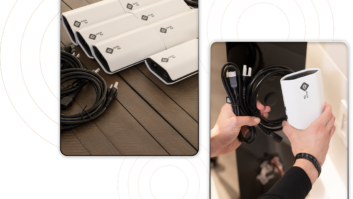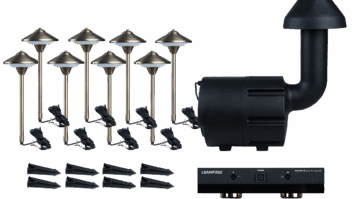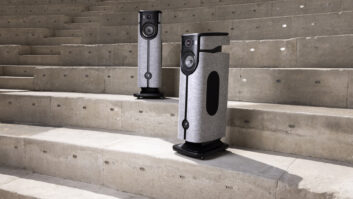There’s a school of thought that says all power amplifiers are the same, so long as you ignore obvious differences like power output. No offense to anyone who subscribes to this philosophy, of course, but if you happen to feel this way, I wish I could personally introduce you to Meridian Audio’s 857 Reference Two Channel Power Amplifier. Not only is it an outright beast of a Class AB machine, with more headroom than I can imagine anyone needing, but it’s also a gentle giant, delivering some of the most detailed and nuanced audio I’ve had the pleasure of hearing in quite some time.
Before we dig too deeply into such superlatives, though, let’s talk basics. The first thing you notice about the 857 is its gorgeous design–no real surprise there, given its manufacturer, but it bears mentioning. The deft mix of gloss and curves gives it a look to which few amps even bother to aspire.
The second thing you notice is that the 857 is a lot beefier than it appears at first glance, tipping the scales at a back-breaking 70.5 pounds (77.1 for the dedicated rack-mount edition). You can probably chalk the bulk of that weight up to its gargantuan high-mass toroidal transformer, although its hefty internal cooling fins don’t exactly help keep the pounds off.


All told, the 857 is capable of cranking out an impressive 250 watts per channel into 8 ohms and 500 wpc into 4 ohms with both channels driven, or a staggering 1000 watts into 8 ohms and 1,500 watts into 4 ohms in Bridge Mode.
The amp is dual-mono and DC coupled, as well as balanced throughout, with unbalanced signals fed to its RCA inputs converted to balanced by way of Meridian’s “Superbal” technology, which I’m not quite sure I really understand, to be frank. But the proof of the pudding is in the listening, so they say.
Before you get to the listening, of course, you have to hook the amp up, which is a mostly straightforward affair. Amazingly, Meridian has still graced the amp with a hardcover instruction manual. That’s right, the user guide is hardbound. It’s also quite well illustrated, so if you have any questions about how to bi-amp speakers or wire up a loudspeaker in Bridge Mode, the answers are all there, gorgeously illuminated and thoroughly indexed.
Inputs and outputs are neatly arranged on the back panel, with the balanced and unbalanced inputs positioned above the two pairs of binding posts for each channel, with the power switch, power receptacle, Bridge Mode selector, and 3.5mm 5-30 VDC trigger input between them. If there are nits to be picked back here, they mostly boil down to the fact that the unbalanced inputs are quite far apart, so if you use bundled interconnects as I do, you may need to split the casing around them to allow for enough wiggle room.
There’s also the fact that the selector switches–for choosing between balanced and unbalanced inputs, as well as for selecting Bridge Mode–aren’t quite built to the same durable and gorgeous standards as the rest of the amp. The Bridge Mode selector switch on my review unit was broken and couldn’t be turned. Keep in mind, though, that this is a review sample that seems to have been passed around more than a left-handed cigarette at a Phish concert.
For the bulk of my review, I relied on my Peachtree Audio Nova220SE integrated amp as a preamplifier, with a pair of Paradigm Studio 100 towers for speakers. To call the combo impressive would be an understatement. Quite frankly, my trusty old Paradigms haven’t sounded this rich, this punchy, this nuanced, and this sweet since I last drove them with my old Anthem five-channel amp. Transparency was unimpeachable. Imaging and soundstage were revelatory. I ran my high-resolution warbles test on the amp and found that with a 96kHz signal, intermodulation distortion was inaudible, making it only the second amp I’ve tested this year suitable for high-resolution audio listening.
There was just one problem–I couldn’t really open up the amp and let ’er rip, since I couldn’t bring the volume on my preamp above about 20 percent. So, I subbed in something a little harder to drive: an old pair of Martin Logan electrostats. I still never even came close to the amp’s breaking point, but I did find mine. What’s funny, though, is that I drove these speakers harder than a rented mule, and never once did the front-panel light on the 857 turn amber (which indicates that it’s operating normally, but with active cooling fans engaged; the other indicators are green for normal fan-free operation, red for overheating, and black for fault protection mode. You can also hold he button for four seconds to blank the front-panel light when the amp is on, but it’ll still go blue in standby mode).
Honestly, I’m kind of afraid to see what kind of speaker you’d have to drive and what kind of cramped environment you’d have to put this amp into just to get its fans to engage. But it’s nice to know that they’re there.
Forget about fans, though. Forget about color changing status lights and swanky binding posts and bulletproof build quality (a few little knobs notwithstanding) because when you’re listening to the 857 Reference Two Channel Power Amplifier, none of that matters. What matters is that you’re probably as close to your music as you’re ever going to get, live performance aside. And what matters for you, the integrator, is that this is probably one amp that you can just install and forget. I’m having trouble imagining what it would take to push it to its limits.







